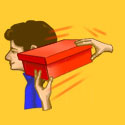




Experiment Category:
Objective:
What You Need:
- Shoe box with cover
- Tape
- Marble
- Two rectangular blocks, each about one-third the width of the shoe box
To Do and Observe:
1) Do this experiment with a friend.
2) Tape the blocks to the inside of the bottom of the shoebox. Don't show your friend where you're taping them. Place a marble in the box. Tape the lid shut. Give the box to your friend.
3) Challenge your friend to figure out the position of the blocks by listening to the marble as it rolls inside the box.
What's Going On:
Sound helps you discover the position of the blocks in the shoebox. The movements and collisions of the marble are the source of the sound. By interpreting the sounds of the marble, you can infer the position of the blocks.
Underwater environments are often too dark and inaccessible to permit direct visual observation. In order to "see" an underwater object, scientists use instruments that depend upon energy other than reflected light. A skilled sonar operator can use the data sonar provides to infer information such as the shape and position of objects. What animals use sonar to locate objects?
Parent/Teacher Tips:
Use only one block inside the box with younger children.
Encourage older children to use more complex block shapes and arrangements.
Help your children think of animals that use sonar. Whales, porpoises, and bats are some examples. Challenge your children to come up with a list of other practical uses for sonar technology. For example: locating wooden studs behind plaster walls.
